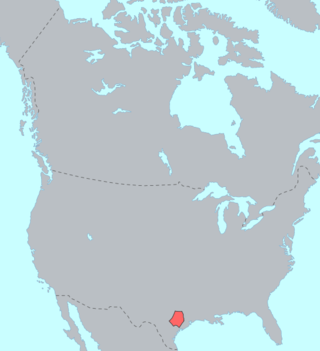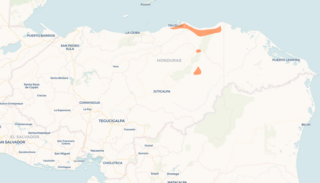
Madí—also known as Jamamadí after one of its dialects, and also Kapaná or Kanamanti (Canamanti)—is an Arawan language spoken by about 1,000 Jamamadi, Banawá, and Jarawara people scattered over Amazonas, Brazil.
Mbula is an Austronesian language spoken by around 2,500 people on Umboi Island and Sakar Island in the Morobe Province of Papua New Guinea. Its basic word order is subject–verb–object; it has a nominative–accusative case-marking strategy.

Tzotzil is a Maya language spoken by the Indigenous Tzotzil Maya people in the Mexican state of Chiapas. Some speakers may be somewhat bilingual in Spanish, but many are monolingual Tzotzil speakers. In Central Chiapas, some primary schools and a secondary school are taught in Tzotzil. Tzeltal is the most closely related language to Tzotzil and together they form a Tzeltalan sub-branch of the Mayan language family. Tzeltal, Tzotzil and Chʼol are the most widely spoken languages in Chiapas besides Spanish.

The Tunica or Luhchi Yoroni language is a language isolate that was spoken in the Central and Lower Mississippi Valley in the United States by Native American Tunica peoples. There are no native speakers of the Tunica language, but there were 32 second-language speakers in 2017, and as of 2023, there are 60 second-language speakers.

The Tonkawa language was spoken in Oklahoma, Texas, and New Mexico by the Tonkawa people. A language isolate, with no known related languages, Tonkawa has not had L1 speakers since the mid 20th centiury. Most Tonkawa people now only speak English, but revitalization is underway.

Kwakʼwala, or Kwak̓wala, previously known as Kwakiutl, is a Wakashan language spoken by about 450 Kwakwakaʼwakw people around Queen Charlotte Strait in Western Canada. It has shared considerable influence with other languages of the Pacific Northwest, especially those of the unrelated Salishan family. While Kwakʼwala is severely endangered, revitalization efforts are underway to preserve the language.
Paumarí is an Arauan language spoken in Brazil by about 300 older adults out of an ethnic population of 900. It is spoken by the Paumari Indians, who call their language “Pamoari”. The word “Pamoari” has several different meanings in the Paumarí language: ‘man,’ ‘people,’ ‘human being,’ and ‘client.’ These multiple meanings stem from their different relationships with outsiders; presumably it means ‘human being’ when they refer to themselves to someone of ostensibly equal status, and ‘client’ when referring to their people among river traders and Portuguese speakers.

Tsez, also known as Dido, is a Northeast Caucasian language with about 15,000 speakers spoken by the Tsez, a Muslim people in the mountainous Tsunta District of southwestern Dagestan in Russia. The name is said to derive from the Tsez word for 'eagle', but this is most likely a folk etymology. The name Dido is derived from the Georgian word დიდი, meaning 'big'.
Pohnpeian is a Micronesian language spoken as the indigenous language of the island of Pohnpei in the Caroline Islands. Pohnpeian has approximately 30,000 (estimated) native speakers living in Pohnpei and its outlying atolls and islands with another 10,000-15,000 (estimated) living off island in parts of the US mainland, Hawaii and Guam. It is the second-most widely spoken native language of the Federated States of Micronesia the first being Chuukese.

Aguaruna is an indigenous American language of the Chicham family spoken by the Aguaruna people in Northern Peru. According to Ethnologue, based on the 2007 Census, 53,400 people out of the 55,700 ethnic group speak Aguaruna, making up almost the entire population. It is used vigorously in all domains of life, both written and oral. It is written with the Latin script. The literacy rate in Aguaruna is 60–90%. However, there are few monolingual speakers today; nearly all speakers also speak Spanish. The school system begins with Aguaruna, and as the students progress, Spanish is gradually added. There is a positive outlook and connotation in regard to bilingualism. 50 to 75% of the Aguaruna population are literate in Spanish. A modest dictionary of the language has been published.

Wagiman, also spelt Wageman, Wakiman, Wogeman, and other variants, is a near-extinct Aboriginal Australian language spoken by a small number of Wagiman people in and around Pine Creek, in the Katherine Region of the Northern Territory.
Baiso or Bayso is a Lowland East Cushitic language belonging to the Omo–Tana subgroup, and is spoken in Ethiopia, in the region around Lake Abaya.

Pech or Pesh is a Chibchan language spoken in Honduras. It was formerly known as Paya, and continues to be referred to in this manner by several sources, though there are negative connotations associated with this term. It has also been referred to as Seco. There are 300 speakers according to Yasugi (2007). It is spoken near the north-central coast of Honduras, in the Dulce Nombre de Culmí municipality of Olancho Department.
Wandala, also known as Mandara or Mura', is a language in the Chadic branch of the Afro-Asiatic language family, spoken in Cameroon and Nigeria.

Ute is a dialect of the Colorado River Numic language, spoken by the Ute people. Speakers primarily live on three reservations: Uintah-Ouray in northeastern Utah, Southern Ute in southwestern Colorado, and Ute Mountain in southwestern Colorado and southeastern Utah. Ute is part of the Numic branch of the Uto-Aztecan language family. Other dialects in this dialect chain are Chemehuevi and Southern Paiute. As of 2010, there were 1,640 speakers combined of all three dialects Colorado River Numic. Ute's parent language, Colorado River Numic, is classified as a threatened language, although there are tribally-sponsored language revitalization programs for the dialect.
Grass Koiari (Koiali) is a Papuan language of Papua New Guinea spoken in the inland Port Moresby area. It is not very close to the other language which shares its name, Mountain Koiali. It is considered a threatened language.

Avá-Canoeiro, known as Avá or Canoe, is a minor Tupi–Guaraní language of the state of Goiás, in Brazil. It can be further divided into two dialects: Tocantins Avá-Canoeiro and Araguaia Avá-Canoeiro. All speakers of the language are monolingual.
Nuaulu is a language indigenous to the island of Seram Island in Indonesia, and it is spoken by the Nuaulu people. The language is split into two dialects, a northern and a southern dialect, between which there a communication barrier. The dialect of Nuaulu referred to on this page is the southern dialect, as described in Bolton 1991.
Longgu (Logu) is a Southeast Solomonic language of Guadalcanal, but originally from Malaita.
Saliba is an Oceanic language spoken on the islets off the southeastern tip of Papua New Guinea. There are approximately 2,500 speakers of Saliba. Significant documentation of the language was undertaken by the Saliba-Logea documentation project, and hundreds of audio-video resources can be found in the project archive.










